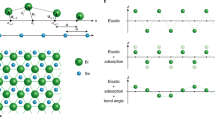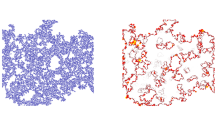Abstract
The branched fractal structures formed by non-equilibrium electrodeposition of metals1 have for several years been considered as model systems for the study of branching and fractal growth processes generally2,3,4,5,6. Most studies have focused on the large-scale structure of the deposits, but the question of how the branching pattern emerges from the nucleation and growth of thepolycrystalline metal at the microscopic scale remains unclear. Here I present experimental and theoretical results which suggest that branched electrodeposits may arise from an oscillatory character in the nucleation kinetics. For this kind of deposition, nucleation is probabilistic but biased towards higher electric fields. I suggest that a given nucleation event is followed by a recovery phase before a subsequent event is possible. This oscillatory nature generates a polycrystalline deposit, the grain size of which determines the level of ‘noise’ which is amplified by the familiar laplacian (‘fingering’) instabilities of non-equilibrium growth2,3,4,5,6 into a macroscopically fractal structure.
This is a preview of subscription content, access via your institution
Access options
Subscribe to this journal
Receive 51 print issues and online access
$199.00 per year
only $3.90 per issue
Buy this article
- Purchase on Springer Link
- Instant access to full article PDF
Prices may be subject to local taxes which are calculated during checkout




Similar content being viewed by others
References
Matsushita, M., Sano, M., Hayakawa, Y., Honjo, H. & Sawada, Y. Fractal structures of zinc metal leaves grown by elecctrodeposition. Phys. Rev. Lett. 53, 286–289 (1984).
Stanley, G. & Ostrowsky, N. (eds On Growth and Form NATO ASI Series Vol. 100(Martinus Nijhoff, Kluwer Academic, Boston, (1996)).
Vicsek, T. Fractal Growth Phenomena, 2nd edn (World Scientific, Singapore, (1992)).
Meakin, P. in Phase Transitions and Critical Phenomena Vol. 12, (eds Domb, C. & Leibowitz, J. L.) (Academic, New York, (1988)).
Ben-Jacob, E. & Garik, P. The formation of patterns in non-equilibrium growth. Nature 343, 523–530 (1990).
Witten, T. A. & Sander, L. M. Diffusion limited aggregation, a kinetic critical phenomenon. Phys. Rev. Lett. 47, 1400–1403 (1981).
Niemeyer, L., Pietronero, L. & Wiesmann, H. J. Phys. Rev. Lett. 52, 1033 (1984).
Chazalviel, J.-N. Electrochemical aspects of the generation of ramified metallic deposits. Phys. Rev. A42, 7355–7367 (1990).
Fleury, V., Chazalviel, J.-N., Rosso, M. & Sapoval, B. Role of the anions in the growth speed of fractal electrodeposits. J. Electroanal. Chem. 290, 249–255 (1990).
Fleury, V., Kaufman, J. & Hibbert, D. B. Mechanism of a morphology transition in ramified electrochemical growth. Nature 367, 435–438 (1994).
Melrose, J. R., Hibbert, D. B. & Ball, R. C. Interfacial velocity in electrochemical deposition and the Hecker effect. Phys. Rev. Lett. 65, 3009–3012 (1990).
Fleury, V. & Barkey, D. Runaway growth in two-dimensional electrodeposition. Europhys. Lett. 36(4) 253–258 (1996).
Despic, A. R. & Popov, K. I. in Modern Aspects of Electrochemistry Vol. 7(eds Conway, B. E. & Bockris, J.O'M.) 199–213 (1972)
Dini, J. Electrodeposition (Noyes, New Jersey, (1992))
Ramasany, P. Handbook of Crystal Growth 1a (ed. Hurle, C. J.) (North Holland, Amsterdam, (1993)).
Bergstrasser, T. R. & Merchant, H. D. in Defect Structure, Morphology and Properties of Deposits (ed. Merchant, H. D.) Proceedings of the Materials Week, Rosemont, 115–168 (TMS publications, Warrendale, PA, USA).
Vetter, K. J. Electrochemical Kinetics — Theoretical AspectsCh. 2, section D, 282–327 (Academic, New York, (1967)).
Budevski, E., Staikov, G. & Lorenz, W. J. Electrochemical Phase Formation and Growth, an Introduction to the Initial Stages of Metal DepositionChs 4, 5 (VCH, New York, (1996)).
Acknowledgements
I am grateful for discussions with D. Barkey; the cell design was in part elaborated in collaboration with him. One series of experiments was prepared with N. Lidgi. I thank A. Chauvineau for lending the AFM. I also shared many stimulating discussions with J.-F. Gouyet, M. Plapp, B. Sapoval, J.-N. Chazalviel, M. Rosso and C. Brissot of the Laboratoire PMC. I acknowledge the help of L.-A. Couturié with image processing.
Author information
Authors and Affiliations
Corresponding author
Rights and permissions
About this article
Cite this article
Fleury, V. Branched fractal patterns in non-equilibrium electrochemical deposition from oscillatory nucleation and growth. Nature 390, 145–148 (1997). https://doi.org/10.1038/36522
Received:
Accepted:
Issue Date:
DOI: https://doi.org/10.1038/36522
This article is cited by
-
Evaporative destabilization of a salt crust with branched pattern formation
Scientific Reports (2023)
-
Synthesis of in situ purified iron nanoparticles in an electrochemical and vibrating microreactor: study of ramified branch fragmentation by oscillating bubbles
Microfluidics and Nanofluidics (2019)
-
Real-time tracking of metal nucleation via local perturbation of hydration layers
Nature Communications (2017)
-
Phase-Field Modeling of Polycrystalline Solidification: From Needle Crystals to Spherulites—A Review
Metallurgical and Materials Transactions A (2014)
-
Unique flexible silver dendrites thin films fabricated on cellulose dialysis cassettes
Journal of Materials Science (2013)
Comments
By submitting a comment you agree to abide by our Terms and Community Guidelines. If you find something abusive or that does not comply with our terms or guidelines please flag it as inappropriate.



